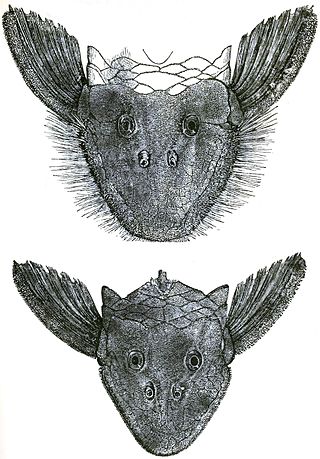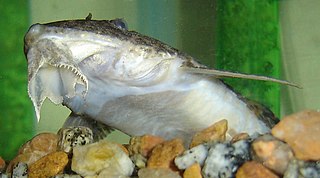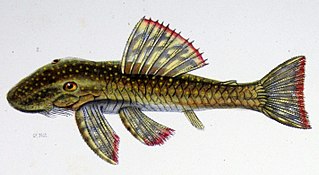
Ancistrus is a genus of nocturnal freshwater fish in the family Loricariidae of order Siluriformes, native to freshwater habitats in South America and Panama. Fish of this genus are common in the aquarium trade where they are known as bushynose or bristlenose catfish. In the aquarium hobby they are often referred to as bushynose or bristlenose plecos instead, but this may lead to confusion as "pleco" usually is used for Hypostomus plecostomus and its allies and is often used as a catchall term for any loricariids remotely resembling that species.

Loricariidae is the largest family of catfish, with 92 genera and just over 680 species. Loricariids originate from freshwater habitats of Costa Rica, Panama, and tropical and subtropical South America. These fish are noted for the bony plates covering their bodies and their suckermouths. Several genera are sold as "plecos", notably the suckermouth catfish, Hypostomus plecostomus, and are popular as aquarium fish.

Hypostomus is a genus of catfish in the family Loricariidae. They are native to tropical and subtropical South America. H. plecostomus is the popular freshwater aquarium fish formerly known as Plecostomus plecostomus. The taxonomic structure of the Loricariidae is still being expanded by scientists. Hypostomus is a highly species-rich and widely distributed catfish genus.

Acanthicus is a genus of large, South American suckermouth armored catfishes native to the Amazon and Orinoco basins, and possibly in Guyana. The name Acanthicus is derived from the Greek, akanthikos meaning thorny, spiny. Fish of this genus are known as lyre-tail plecos. These species are found in large rivers, primarily in areas with a rocky bottom and a moderate or strong current.

Pseudancistrus is a genus of suckermouth armored catfishes native to South America.

Rineloricaria is a genus of freshwater tropical catfish belonging to the family Loricariidae. They are commonly called whiptail catfish because of the long filament that grows out of the tip of the caudal fin that is characteristic of the genus. With the exception of R. altipinnis from Panama, they are native to the rivers of northern and central South America. Some species are regularly seen in the aquarium trade.

Hypancistrus is a genus of loricariid catfish originating from the Amazon basin in South America. Unlike many of the other Loricariids, however, some Hypancistrus species are more carnivorous and enjoy meat in their diet. Hypancistrus species are popular aquarium fish, including such popular fish as the zebra pleco and Queen Arabesque pleco.

Peckoltia is a genus of small South American armored suckermouth catfishes. Many of these fish are popular aquarium fish.

Corymbophanes is a genus of armored catfish native to South America where they are only known from Guyana. Corymbophanes was originally placed in its own tribe Corymbophanini, but the first comprehensive molecular phylogenetic analysis of the subfamily Hypostominae found Corymbophanes to be nested within the tribe Ancistrini.
Ixinandria steinbachi is the only species in the genus Ixinandria of catfish of the family Loricariidae.
Lamontichthys is a genus of armored catfishes native to South America.
Dasyloricaria is a genus of armored catfishes native to Central and South America. The distribution of these species includes the northwestern South America on the Pacific slope of Colombia and Panama. Its distribution is restricted to the Pacific slope of the Andes, which is a unique pattern of distribution within the subfamily.
Dekeyseria is a genus of suckermouth armored catfishes native to tropical South America.

Lasiancistrus is a genus of suckermouth armored catfishes. They are native to South America and Panama.
Lithoxus is a genus of suckermouth armored catfishes native to tropical South America.

Leporacanthicus is a genus of suckermouth armored catfishes native to South America.
Pseudolithoxus is a genus of suckermouth armored catfishes with five described species from the basins of the Orinoco, Casiquiare and upper Rio Negro in Venezuela. Additionally, a possibly undescribed species is known from the Trombetas and Nhamundá rivers in Brazil.
Pseudolithoxus tigris is a species of armored catfish endemic to Venezuela where it is found in the upper Orinoco and Ventuari River basins. This species grows to a length of 9.4 centimetres (3.7 in) SL.
Ancistrus trinitatis is a dubious species of catfish in the family Loricariidae. It is known only from the Caribbean, where it occurs in freshwater environments on the island of Trinidad in Trinidad and Tobago. This species is of uncertain validity, as Theodore Gill referred to the type material in 1858 as Ancistrus guacharote and it was later described by Albert Günther in 1864 as Chaetostomus trinitatis, but neither description is considered sufficient to determine the validity and identity of the taxon. While the original locality of the type material was listed as Puerto Rico, this was determined to be in error and the material was determined to have actually originated from the Maracaibo Basin of Venezuela. In 1946, Henry Weed Fowler described the species Ancistrus maracasae from Trinidad, and in 2019, Lesley S. De Souza, Donald C. Taphorn, and Jonathan W. Armbruster determined that A. maracasae and A. trinitatis are synonymous, designating the holotype of A. maracasae as the neotype of A. trinitatis, although sources such as FishBase and ITIS list the two species as valid but separate.
Neblinichthys peniculatus is a species of catfish in the family Loricariidae. It is native to South America, where it occurs in the Carapo River, which is part of the Paragua River basin in Venezuela. It is reportedly found in two rapids complexes in the Carapo. The species reaches 8.1 cm SL.










